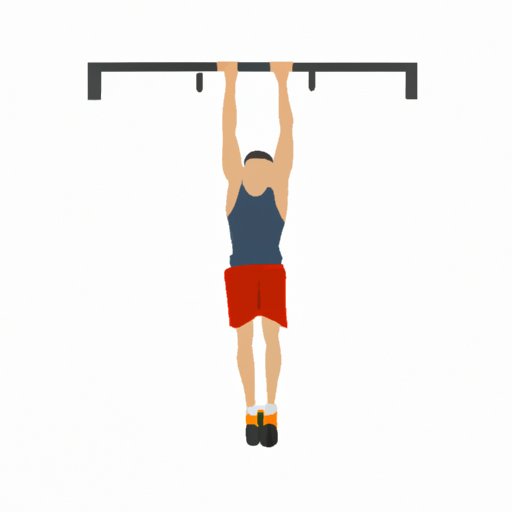
Introduction
Pull-ups are an effective, full-body exercise that can help increase strength and build muscle. However, mastering this exercise can be challenging, especially for beginners. In this article, we’ll discuss the benefits of pull-ups and offer a step-by-step guide for beginners, strategies for incorporating pull-ups into your workout routine, tips for overcoming common challenges, and strategies for building endurance and strength.
Mastering the Pull-Up: A Step-by-Step Guide for Beginners
Before we can start breaking down the steps for a pull-up, it’s important to understand the muscles involved. Pull-ups mainly work the back muscles, including the lats, rhomboids, and trapezius. Additionally, the biceps, forearms, and core are also engaged.
Here are the basic steps for mastering the pull-up:
- Begin by grabbing the pull-up bar with an overhand grip, hands shoulder-width apart.
- Engage your shoulder blades and pull them down and back, like you’re trying to put them in your back pocket.
- As you begin to pull your body upward, keep your elbows tucked close to your body.
- Continue to pull yourself up until your chin is above the bar.
- Lower yourself down slowly, making sure to keep control of your body movements.
For beginners, it’s important to start with the basics. If you’re not able to do a full pull-up yet, start by doing assisted pull-ups. This can be achieved by using a resistance band or an assisted pull-up machine. Work on negatives by lowering yourself down slowly after jumping up to the pull-up bar. As you continue to practice, you’ll gradually develop your strength and be able to do a full, unassisted pull-up.
Adding Pull-Ups to Your Workout Routine: Tips from a Personal Trainer
Pull-ups are a great addition to any workout routine. Not only do they work multiple muscle groups, but they also help improve grip strength and overall posture. Certified personal trainers suggest starting with a few assisted pull-ups and gradually working your way up to full pull-ups. Incorporating a variety of different grip positions, such as wide grip and close grip, can help target different muscle groups and add variety to your workout. Including pull-ups as part of a complete workout regimen can improve performance in activities such as weight training, running, or cycling.
Here’s a sample workout plan that incorporates pull-ups:
- Warm up with five minutes of light cardio, such as jogging or jumping jacks.
- Do three sets of assisted pull-ups with a resistance band, aiming for eight to 10 reps per set.
- Complete three sets of lat pull-downs with a cable machine, again aiming for eight to 10 reps per set.
- Pair your pull-up exercises with other upper body exercises, such as chest presses or push-ups to continue working different muscle groups in your upper body.
Overcoming Common Pull-Up Challenges: Solutions and Techniques
For many beginners, mastering a pull-up can feel daunting, but with persistence it can be achieved. One of the most common issues is struggling with grip strength. If this is the case, consider using tools such as hand grips, gloves, or chalk. To prevent unnecessary stress on the elbows and shoulders, it’s important to avoid swinging your body while you’re lifting yourself. Aim for a smooth, controlled motion throughout the exercise. Additionally, as with any exercise, proper form is key. Make sure to engage your core muscles so you don’t arch your back or allow your feet to sway back and forth.
How to Train for Pull-Up Endurance: Strategies and Workouts
If you’re looking to improve your pull-up endurance, it’s essential to develop strength in other areas as well. Incorporating exercises that target your back muscles, such as rows and lat pull-downs, can be beneficial. Another strategy is to focus on the eccentric or lowering phase of the exercise. After you’ve completed a full pull-up, try lowering yourself down slowly and with control. This phase of the exercise can help build strength and endurance. Here’s a sample endurance-focused pull-up workout:
- Begin by warming up with five minutes of light cardio, such as jogging or jumping jacks.
- Follow with three sets of assisted pull-ups using a resistance band, aiming for eight to 10 reps per set.
- Complete three sets of lat pull-downs with a cable machine, again aiming for eight to 10 reps per set.
- Finish with three sets of controlled pull-up lowers, aiming for three to five reps per set.
The Anatomy of a Perfect Pull-Up: Breakdown and Analysis
To enhance your understanding of proper pull-up mechanics, it’s important to break down the exercise into each phase. Here’s a brief overview of each part:
- Initiate the exercise by flexing the elbow and shoulder joint simultaneously and start pulling up.
- When your chest touches the bar, pause for a second to hold your chin above the bar.
- Lower the body under control along the original route to your starting position.
The key to performing a perfect pull-up is consistency. Focus on keeping your movements controlled and avoiding unnecessary swinging. Maintaining proper form throughout each phase of the exercise can also help prevent injuries and ensure you’re getting the maximum benefit from the exercise.
Conclusion
Mastering the pull-up can be a challenge, but it’s an effective way to build strength and increase muscle. Whether you’re a beginner or an experienced fitness enthusiast, incorporating pull-ups into your workout routine can improve your overall fitness. By following the tips and strategies outlined in this article, you’ll be well on your way to doing a perfect pull-up in no time. Keep practicing and make sure to gradually increase the intensity and duration of your workouts. You’ll be amazed at the progress you can make with consistency and dedication.




